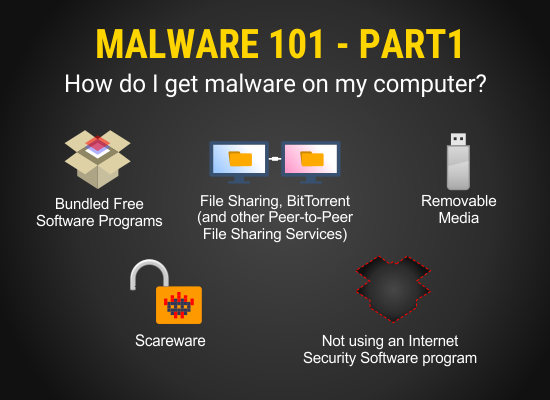How Do You Remove Malware Off Your Computer?




 (1 votes, average: 5.00 out of 5)
(1 votes, average: 5.00 out of 5)Malware infection occurs when malware or malicious software infiltrates your computer. Since most people are connected to the internet than ever before, hackers are tricking unwary users into downloading malware.
What is Malware?
Malware is a type of software created with the intent of damaging the victim’s computer, steal private information or spy on a computer without the consent of the user.
The most popular categories of malware are Trojans, viruses, spyware, ransomware, adware, rootkits, worms, etc. Each of these malware types varying capabilities. From spying on your online activities to slowing down or locking down your computer, malware can wreak havoc on your computer if you do not protect yourself against them.
How Does Malware Get On To Your Computer?
Malware can enter your computer via fake websites that are specially designed to exploit security flaws (aka bugs) in your computer browsers. It can be inadvertently downloaded on your system when you download seemingly good software from such shady websites. It can also infect your computer via malicious email attachments, or a deceptive web link.
How Do You Get Malware Off Your Computer?
Since there are multiple variants of malware in existence, it is difficult to precisely pinpoint the specific type of malware that has infected your computer. Odds aside, if you are well aware of the specific malware that’s hiding in your PC, you can use antivirus software like Xcitium Antivirus to remove it completely from your computer.
Chances are, however, that you will not be able to distinguish the specific malicious program from your system files or programs. If that is the case, here are some of the tips on how do you get malware off your computer.
Cutoff the Internet Connection To Your Computer
Once you are aware of the malware infection on your computer, make sure to disconnect the internet connection to your computer. Since the hackers may have access to your personal information or may even be using your computer to attack other computers, it is advisable to make your computer offline by disconnecting the internet connection.
Uninstall Suspicious Applications
If you detect a suspicious application, you can use the process below to get rid of it. Free antivirus software can also help detect and remove malware.
1. Go to Start menu and Click Settings.
2. Once you enter the Settings menu, select Apps & features option.
3. Locate the suspicious application you wish to uninstall.
4. Click on that application name and click the Uninstall button that appears below it.
Install or Update Your Antivirus
If you have an antivirus program installed on your computer, make sure it is up-to-date with the latest virus definitions. Antivirus vendors regularly update virus definitions as they encounter new viruses and Trojans in the wild and their labs. If your antivirus software is even a day out of date, you run the risk of infection.
If you don’t have an antivirus program, install Good Antivirus Software such a Xcitium antivirus and run a full scan to check for malware.
For organizations, finding and removing malware is not easy. There may be multiple legacy endpoints/devices deployed at different locations. Due to that, conventional antivirus products are not a viable option.
Xcitium Advanced Endpoint Protection (AEP) is an ideal solution for such scenarios as it offers all-around protection across devices and OS platforms. Xcitium AEP allows only known good files to run on a device with unlimited access, enabling users to run anything on their computer without fear of infection.
For more details about Xcitium Advanced Endpoint Protection, contact us at +1 888-256-2608.
Related Sources:
Endpoint Detection and Response
What is Anti Malware Protection?
What is Malware?
What is Malware Scanner?
Best Online PC Scan Tools
What is EDR?
Free Desktop Management Tools
